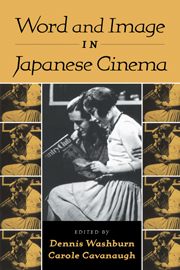Book contents
- Frontmatter
- Contents
- List of Illustrations
- Contributors
- Foreword: Outside Views of the Japanese Film
- Introduction
- PART ONE WORDING THE IMAGE/IMAGING THE WORD
- 1 The Word before the Image: Criticism, the Screenplay, and the Regulation of Meaning in Prewar Japanese Film Culture
- 2 The Cinematic Art of Higuchi Ichiyô's Takekurabe (Comparing Heights, 1895–1896)
- 3 Once More and Gosho's Romanticism in the Early Occupation Period
- 4 The Taunt of the Gods: Reflections on Woman In The Dunes
- 5 Adapting The Makioka Sisters
- 6 In the Show House of Modernity: Exhaustive Listing in Itami Jûzô's Tanpopo
- PART TWO REFLECTIONS OF IDENTITY
- PART THREE OUTSIDE THE FRAME OF CULTURE
- Selected Bibliography of Articles and Books in English
- Index
4 - The Taunt of the Gods: Reflections on Woman In The Dunes
Published online by Cambridge University Press: 01 March 2010
- Frontmatter
- Contents
- List of Illustrations
- Contributors
- Foreword: Outside Views of the Japanese Film
- Introduction
- PART ONE WORDING THE IMAGE/IMAGING THE WORD
- 1 The Word before the Image: Criticism, the Screenplay, and the Regulation of Meaning in Prewar Japanese Film Culture
- 2 The Cinematic Art of Higuchi Ichiyô's Takekurabe (Comparing Heights, 1895–1896)
- 3 Once More and Gosho's Romanticism in the Early Occupation Period
- 4 The Taunt of the Gods: Reflections on Woman In The Dunes
- 5 Adapting The Makioka Sisters
- 6 In the Show House of Modernity: Exhaustive Listing in Itami Jûzô's Tanpopo
- PART TWO REFLECTIONS OF IDENTITY
- PART THREE OUTSIDE THE FRAME OF CULTURE
- Selected Bibliography of Articles and Books in English
- Index
Summary
Things made of clay are easily broken. When a piece is on the point of being broken and yet retains its integrity – this is the point at which it is beautiful.
Teshigahara (quoted in Ashton, 1997)When first released, in 1964, Woman in the Dunes an independent production made on a limited budget (about $100,000) achieved a kind of cult status in the West. In the film, and in the novel by Abe Kôbô on which it was based, we can recognize an updated version of the myth of Sisyphus the man imprisoned in the Absurd and tormented by the need to find a meaning to his circumstances as an allegory of our time. The pit and the desert are represented as places of synthesis, based on a dynamism of opposition and of merging rules. These are the qualities that make this film both accessible and obscure, universal and specific.
Woman in the Dunes is a meditation on identity. This is made explicit by Teshigahara, the director, from the opening credit scene in which a mass of hanko (name-seals) fills the screen. The woman is never named and the man's proper name – Junpei Niki is given only at the end of the film. The entomologist is first introduced as a character tied to identity cards that are his social credentials. The novel, divided into two parts, opens with the statement “One day in August a man disappeared” and closes with the man's decision that “there was no particular need to hurry about escaping.”
- Type
- Chapter
- Information
- Word and Image in Japanese Cinema , pp. 89 - 107Publisher: Cambridge University PressPrint publication year: 2000



